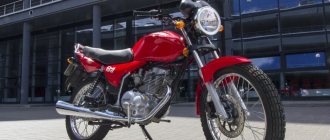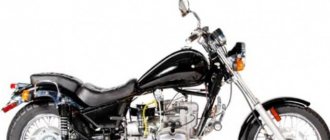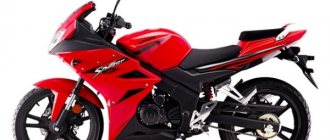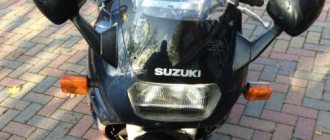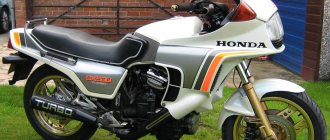All models of Soviet and Russian Ural motorcycles belong to the priority class of the domestic motorized industry. The devices have several modifications, and modern copies are actively used by consumers. The manufacturer tries to maintain the optimal combination of quality, power and cross-country ability of the unit. It offers modern two-wheeled machines of a single type and with the possibility of basing a side trailer. Let's look at the characteristics and features of the most popular samples.
History of development and creation
All models of Ural motorcycles, to one degree or another, copy the German brand BMWR. The very first prototype was created by Soviet designers in 1939. There are two main versions about the origin, and it is currently not possible to verify their authenticity.
Presumably the German analogue was transferred to the Soviet Union for review, after which domestic developers released a similar modification. The second option involves the purchase of originals in Sweden, their further transportation to the USSR, and the manufacture of the vehicle in question.
It is reliably known that in 1941 motorcycles were produced under the symbol M-72, which were similar to their German “relatives”, like twins. Serial production of the equipment was approved by Joseph Stalin himself. Production was organized at a Moscow plant, however, due to the martial law, the production of machines was moved to Siberia (the small town of Irbit). It is noteworthy that the production workshops were equipped in a former beer factory due to the lack of available suitable premises.
Ural Tourist - a quick review of the classic Russian heavyweight
The Irbit Motorcycle Plant has been known throughout the world for its Urals since 1961. And, apparently, these motorcycles are still of interest to someone, since to this day they are produced in almost their original form and, moreover, are successfully sold at a price of around 10 thousand US dollars.
It’s difficult to say what motivates the plant’s management - a focus on antiquity, a lack of funds for modification, or a tribute to the tradition of mockery of the domestic consumer of our motor market, but in various modifications, Ural motorcycles coming off the assembly line continue to resemble those distant 60s, when it was fashionable in the city crossed on motorcycles with sidecars. However, let's take a closer look at this two-wheeled product.
All Ural motorcycles are descendants of the M-72 model, which was a copy of the Bavarian R71 (BMW). Thus, the motorcycle is based on a completely viable design (it is not clear why these wasteful Germans went further and began producing modern supersports with luxury tourists and abandoned such a “tenacious” motorcycle as the BMW R71.). Urals are produced with or without sidecars (Ural Tourist is a model with a sidecar), and the sidecar can be equipped with a switchable drive without a differential.
The motorcycles are equipped with a classic four-stroke opposed gasoline internal combustion engine with two cylinders. The total engine volume is 745 cm³ and its power is 40 hp. The entire herd of horses is cardanally transmitted to the rear wheel, controlled by a 4-speed gearbox.
Ural "Tourist" is an all-terrain motorcycle. It goes well both on the highway and off-road. As you understand, our roads are not a problem for it - the device “swallows up potholes and potholes on the go.” Such abilities of this two-wheeler are facilitated by its considerable weight (335 kg of dry weight) and a successful suspension: the long-link front fork at the front can withstand any overload on the road, and the hydraulic brakes will easily stop the Ural “Tourist” from any speed at which it decides and can accelerate (maximum speed is 120 km/h).
"Ural M-72"
All models of Ural motorcycles are based on the military model of the M-72 type. The initial delivery from Irbit to the army began already in 1942. The total number of military motorcycles was more than 9,700 pieces. The production of the device continued until 1954. During this time, more than three million copies were produced.
The civilian modification of the vehicle in question was released under the symbol M-52. Structural changes allowed the model to move quickly and steadily along the asphalt. The power unit is a four-stroke engine with a volume of five cubic centimeters. The characteristics of the engine allowed the device to accelerate to 100 kilometers per hour with a power of 24 hp. With. It is worth noting that this version went on sale, but each owner had to register the bike with the military commissariat.
Scoopcycles
I'll start with the most ancient M-72, the ancestor of which is the BMW-R71.
The motorcycle began to be produced in 1941, primarily for motorcycle units of the Red Army. A 22-horsepower boxer engine with a volume of 746 cubic meters was installed as a power unit. As a result of subsequent modifications, the power increased to 27 l/s. The weight of the motorcycle is about 220 kg, and the maximum speed is 105 km/h. This is where the Urals began! I would like to note that to this day this motorcycle model is produced in China under the name “Chang-Xiang” and is even exported.
The next stop in the story was the M-52. This model was already made as a road motorcycle and was intended more for high-speed riding on asphalt than for off-road travel. The Ural M-52 was equipped with a 500 cc four-stroke two-cylinder engine. cm and a power of 24 hp, which made it possible to reach a speed of 110 km/h. Today it is considered one of the rarest Soviet production motorcycles.
Given the continued demand for models with off-road performance, the new M-61 model (1960-1961 production year) was born. The Ural M-61 was made on the same chassis as the M-72 and M-52, but this model had a 650 cc engine. cm and power 28 hp. Already more suitable for driving on rural roads. This model was produced from 1957 to 1963.
The birth of the M-62 dates back to 1961-1965. The new Ural model has been significantly modernized; it has automatic ignition timing, thanks to which engine power has increased by 2 hp. With. and amounted to 28 hp, a new gearbox and increased suspension travel. The weight of the motorcycle is 320 kg, and the maximum speed remains about 100 km/h.
The first Ural M-63 rolled off the assembly line in 1964 and became the first model with a pendulum rear wheel suspension. Also new in this model are hydraulic shock absorbers and new mufflers. Production of this model ended in 1971.
In 1971, the M-63 was replaced by a new model, the M-66 (I feel as if I’m writing about girl models (:). So, the M-66 differed from the previous ones in the “upgrade” of the engine, which increased its power to 32 hp Namely, an oil filter was added, and the front engine cover was changed accordingly.Like everything else in this world, the production of the M-66 came to an end in 1973.
“Ural” M-67 (1973-1976) and “Ural” M-67-36 (1976-1983) were not particularly different in appearance. The difference between the M-67 and the previous model was the 12-volt generator used for the first time. And on the M-67-36 model, the designers again worked on the engine and squeezed 36 hp out of it. They found these missing horses in modified cylinder heads (the stroke angles and diameter of the valve plates, and accordingly the valve rocker arms, changed).
The next model was the Ural IMZ-8.103-30 (1983-1986). As can be seen from the photo, the new motorcycle model was equipped with an exhaust system with one muffler. Changes also affected the rear suspension; it became a lever suspension with double-acting spring-hydraulic shock absorbers, adjustable in height.
I will call this part “Our days” , because... the following motorcycles are still produced to this day.
“Ural” IMZ-8.103-40 Tourist model is equipped for the first time with a lever front fork. In recent years, engineers at the Irbit Motorcycle Plant have been constantly improving this model, and achieving very good results. First of all, it should be said that the latest Tourist models are equipped with new four-stroke two-cylinder engines with a power of 45 hp and a displacement of 750 cc. This allows the updated motorcycle to accelerate on the highway to a speed of 120 km/h.
“Ural” IMZ-8.123 Solo is a single vehicle based on IMZ-8.103-10. The model is equipped with a four-speed gearbox with reverse gear, front telescopic and rear pendulum suspension, electric starter, front hydraulic disc brakes, rear drum brakes and safety bars. The latest modifications of the Ural Solo motorcycle are equipped with the same engine as the Tourist, which produces a maximum speed of about 130 km/h.
"Ural" IMZ-8.1037 GEAR-UP is a militarized model of a modern road motorcycle, the production of which began in 2005. The same “Tourist” was taken as a basis. It has two drive wheels with a differential-free transmission, which significantly improves the off-road performance of the motorcycle and equipment for installing various weapons.
“Ural” IMZ-8.1238 Wolf can rightfully be considered a unique creation of the domestic motorcycle industry. And this is not surprising, because the Ural Wolf is the first full-fledged Russian chopper. Its mass production was started by the Irbit Motor Plant in 1999, and since then this model has enjoyed considerable success not only among domestic buyers, but also abroad. Another interesting fact is that the concept of this first Russian chopper was developed by factory engineers together with representatives of the famous Russian biker club - “Night Wolves”. The main feature of this model is its very long wheelbase of 1690 mm. Among other significant technical features, it is distinguished by a very powerful engine - its volume is 745 cubic centimeters and its performance is 40 horsepower. The engine provides a decent top speed of the motorcycle, under suitable conditions it can accelerate to 150 km/h, and acceleration to 100 km/h occurs in 10 seconds.
“Ural” IMZ-8.1036 Retro , as a result of all the modernizations, the motorcycle not only became one of the most stylish motorcycles in the model line, but also passed certification for the European and American markets. The Ural "Retro" motorcycle with sidecar is equipped with a 750 cc opposed four-stroke two-cylinder engine. cm and a power of 45 hp. Maximum speed 120 km/h. The Urals with a sidecar are incredibly popular abroad, especially in the USA, so the Irbit plant has no problems with the sales market today. In 2001, the plant produced a modification of the Ural “Retro” without a sidecar, and two years ago, for demonstration at the Haynes International Motor Museum in England, a unique model of the Ural “Retro” motorcycle with right-hand drive was developed. By the way, the right-hand drive version also appealed to the Japanese, who purchased several models. The facts speak for themselves)))
In this article I tried to describe the history of the development and modernization of Ural motorcycles and the characteristics of the main production models. If you have any comments or suggestions, I will be happy to listen. I plan to write similar articles about other monsters of the domestic motorcycle industry.
Features of the M-61 and M-66 variations
All Ural motorcycle models cannot be considered without two modifications that came out in the sixties of the last century. Changes in the design were minimal, however, an updated pendulum-type suspension mounted on the rear wheel appeared on the M-61/63.
On the 66th modification, a modified engine was used, the power of which was 32 hp. With. Then samples with a 36-horsepower unit were released. Changes in the engine design and other improvements led to the creation of the last Soviet Ural, brand 8.103-3O. Its main difference from its predecessors was the presence of an automobile-type driveshaft and a chain drive. In addition, it is worth noting an improved exhaust system and a cheaper version for the outback and remote villages.
Ural with a sidecar, green
Completely completed from A to Z by me personally. It took about six years from the start of the project to completion.
The engine is homemade. Volume 770 cm3. The crankshaft from the K-750 is installed in the Ural crankcase. The cylinders were made from K-750 cylinders. First, the place where the valves are located was cut off the cylinder with a grinder. Then, under factory conditions, the metal is removed from the side of the combustion chamber until a continuous mating plane is formed around the cylinder bore. The threads of the bolts for the “casket” head are plugged before this. The cooling fins are ground off and the mating plane of the cylinder to the crankcase is machined. Then a flask is made in a foundry, and the cylinders are filled with aluminum. Then the turner cut the cooling fins, and the boring machine made holes for the rod casing and drainage pipe. Lastly, the cylinders were bored to fit custom pistons with a diameter of 79 mm. VAZ rings. Piston pins with a diameter of 22 mm.
Electronic ignition from VAZ parts. Clutch disc from 401 Moskvich. Barbells from Ural Voyage. The rocker arms are a mixture of Ural and Dnieper ones. Since they are taller than the standard Ural ones, we had to cast higher valve covers so that the rocker arms would not touch them. Generator 500W. Bearings and seals are imported.
The box from the M-72 (I love them very much, they are beautiful and reliable) is standard. Homemade air filter for “Volkovsky” filter element. The cardan is made new. Bridge 8th. Spark plug pendant, completely restored. The fork is Ural, extended with inserts, and has Java seals. The stroller wheel suspension is torsion bar from M-72. Cradle on springs. The wheel axles are made of steel. 30HGSA, like the cardan, and are heat treated to a hardness of 35-45 HRC. The crossbars are made according to my drawings, as are the wheel hubs. The steering wheel is widened for ease of control, the steering columns are made of stainless steel.
Wheels 16 inches from a BMW car. Tires 275/70/16 from an SUV. Calipers, brake cylinder and brake discs from VAZ. Three bearings are installed in the hubs of the front and rear wheels (conical at the edges and ball in the center) to avoid deflection of the wheel axis.
The wings, gas tank and cradle are welded independently. The rear wing is welded from two sidecars. All work on preparing and painting the motorcycle was carried out personally in a garage.
The exhaust system is made of stainless steel, the intake manifolds are ordinary Ural. The headlights are made from old Ural ones, one has a standard speedometer, and the other has an electronic tachometer made by my friend. The marker lights on the rear fender and sidecar fender are taken from truck trailers and chromed. I made the fasteners for these headlights from stainless steel sheets and polished them.
The stroller seats are made from the back seat of a Ford Jeep. The stroller cover and seats are upholstered in the QUANTRO studio.
The motorcycle frame, sidecar frame, sidecar springs, wheels, calipers and brake discs and every little thing are sandblasted and powder coated. The motorcycle has a conclusion from the Serpukhov Scientific Research Institute of the Motorcycle Industry on the possibility of operating this vehicle on public roads.
More pictures of the construction of this motorcycle on my website
New models of the Ural motorcycle
After the collapse of the Union of Soviet Socialist Republics, the population began to buy motorcycles less due to the economic crisis. Those who had the means to purchase preferred foreign brands. However, the plant in Irbit did not stop production, although the products were sold in minimal quantities.
The plant was privatized in 1992 and renamed JSC Uralmoto. The designers of the updated plant were able to cope with the critical situation, and even developed a line of fundamentally new modifications.
For example, the latest models of the Ural motorcycle of the Tourist category began to be equipped with a lever fork and new power plants (four strokes), which had a volume of 750 cubic meters and a power of 45 horses.
The Ural Solo modification is a modernized version for movement without a side trailer. It is equipped with a four-speed transmission, electric start, reverse gear and a reliable disc brake system. The maximum speed of the device is 130 kilometers per hour.
Purpose
In the Russian outback, the Ural “Tourist T” has become a desirable and, importantly, inexpensive “trophy” for avid bikers, hunters, fishermen, farmers and foresters. A durable front suspension will ensure fast and trouble-free driving on forest paths and curved paths, damaged asphalt and potholes on the highway. Without much difficulty, a 335-kilogram transport with a sidecar overcomes rough terrain with viscous soils or swamps.
Three passengers (with backpacks and luggage, total weight up to 285 kg) riding this massive motorcycle will get a lot of pleasure from an active holiday spent together with the “Tourist”. Its maximum speed is 120 km/h, which the bike can only reach on a good road.
What other models of Ural motorcycles are there?
The Ural Retro motorcycle is considered the most stylish in the line under consideration. It is stylized in an antique style and is successful not only in the domestic market, but also in the UK and the USA. Right-hand drive versions have been developed for ease of adaptation in countries with special traffic regulations.
The IMZ plant launched another modernization in 2014, which made it possible to change the characteristics of all production models. The parts have undergone significant processing, as well as strengthening of component elements, ranging from body kits to the power unit and fuel system. Among the innovations, the following innovations can be distinguished:
- the emergence of electronic fuel injection;
- equipping all wheels with disc brakes;
- installation of a hydraulic steering damper;
- use of composite materials in the layout.
The compatibility of Soviet developments and modern technologies made it possible to bring Ural motorcycles (photos of all models are presented in the article) to world-class quality. The success is evidenced by real figures, which indicate that more than 90 percent of the equipment produced by this manufacturer is exported.
Specifications
Moving on to the technical characteristics, it is worth noting that they are no different from the usual properties for most IMZ motorcycles.
The 2-cylinder engine with a volume of 745 cc works great here. cm.
A modern microprocessor ignition system provides the driver with the ability to easily and quickly start the engine.
A manual 4-speed variable gearbox is installed. The rear wheel is driven by a driveshaft.
The fuel tank holds 19 liters of AI-92 gasoline. Fuel is consumed at the rate of 5-6 liters per 100 km of city streets.
If the speed is cruising, then it is approximately 105 km/h, and the maximum speed reaches 120-130 km/h .
| Technical characteristics of Ural Solo (Ural Solo) | ||
| Motorcycle dimensions | mm | L2300xW850xH1100 |
| Dry mass | kg | 234 |
| Total weight | kg | 384 |
| Ground clearance | mm | 125 |
| Fuel tank | l | 19 |
| Fuel consumption | l per 100 km | 5-6 |
| Engine | type | boxer OHV, 4-stroke |
| Cylinder | count | 2 |
| Engine starting | type | kickstarter and electric starter |
| Ignition system | type | microprocessor |
| Variable gearbox | type | 4-speed, reverse |
| main gear | type | gimbal |
Peculiarities
Among the export and trial models of the Ural motorcycle, the following examples can be distinguished:
- "Ural-T" is a modern analogue of the first modification, which has updated characteristics.
- “Tourist” is a variation focused on movement on various types of soil, with the ability to connect a side stroller.
- The military variation of the Ural Gear Up is equipped with a place for installing a machine gun turret, a bumper pipe, an enlarged headlight and has a corresponding color.
In addition, the IMZ line includes biker versions “Cross” and “Wolf”, equipped with chrome parts, as well as all-terrain vehicles “Sportsman”, “Patrol”, “Yamal”.
Modifications
The diverse motorcycle fleet of IMZ was decorated with new modifications of the “Tourist”:
- The khaki-colored “uniform” and special equipment are the distinctive features of the “Gear-Up” heavy motorcycle, which has been in service in the Russian Armed Forces for almost 18 years.
- Going for export, Ural “Retro”, which is still successfully sold in the car market of Western countries. It is created on the basis of the basic model of the "Tourist".
- Ural "Tourist 2WD", equipped with all-wheel drive.
- Choppers are one of the design ideas of IMZ. For example, the “Wolf” model is available with an extended frame and front fork.
- “Tourist T” is the main novelty of Uralmoto for the last 10 years. This motorcycle model, intended for foreign buyers, has become the most popular and sought-after brand of heavyweight bike “over there.”
To conclude the review
The domestic motorcycle “Ural”, the history of which models are discussed above, has become a real legend of the motorcycle industry. Even during the war years (1941-1945) it was intended for the army. However, later the use of this heavy motorcycle moved into the civilian sphere.
The equipment was especially popular in villages and villages because it had good load-carrying capacity and cross-country ability. All modern Ural motorcycle models, along with their characteristic style, have acquired completely new driving parameters and are in demand not only in the post-Soviet republics, but also abroad. Their exhibition can be seen at the Irbit State Motorcycle Museum.
Upgrades and average cost
The creators of the Ural Solo sT motorcycle are constantly modernizing their brainchild, so motorcyclists can always see new configurations, as well as various innovative developments.
On the modern market, the Ural Solo 2015 model year costs approximately 349,000 rubles. For the Retro Solo model you will have to pay 576,840 rubles.
A Ural Solo sT motorcycle produced in 2011 will cost approximately 350,000 rubles, and a motorcycle produced in 2015 will cost 455,000 rubles.
As for used models, a 1996 Ural Solo can be bought for 50,000 rubles.
An older model, produced in 1994, will cost 35,000 rubles. Ural Solo 2002 will cost 75,000 rubles.
Not long ago, the Suzuki Intruder 400 was named the best city motorcycle. I wonder why? Then read our review.
The fastest sports bike from Suzuki:


